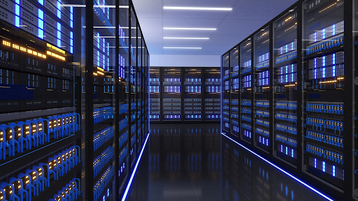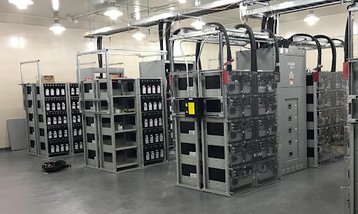In the near future, the global energy landscape is poised to shift dramatically, with a reduced reliance on fossil fuels.
The COP27 UN Climate Change conference saw nearly 200 countries reaffirm their commitment to limit global temperature to rise to 1.5°C (2.7°F) above pre-industrial levels.
That said, the world is perilously off course to keep this limit within reach and a bleak report published by the UN Climate Change shows current pledges put us on track for a 2.5°C (4.5°F) rise by the end of the century.
With the seriousness of the environmental threats the world faces, there is a heightened emphasis on replacing fossil-fuel generated electricity with renewable energy sources like wind and solar power.
However, the intermittent nature of these sources poses a significant challenge when it comes to integrating them into the existing power grid infrastructure.
This article explores how data center energy storage can play a dual role in backup and grid balancing, not only ensuring customer data integrity but also facilitating the clean energy transition, thereby lowering the overall carbon footprint.
Emerging trends in the energy sector
Accelerating solar and wind generation site additions are driving the growth in renewable energy supply. According to the International Environment Agency (IEA) 2022 was a record year for renewable capacity additions and is expected to jump by a third in 2023.
Nevertheless, this activity needs to ramp up sharply to align with the Net-zero Emissions by 2050 (NZE) scenario. In the run-up to COP28 – which took place at the end of 2023 – the IEA prepared its ‘Tracking Clean Energy Progress 2023’ report, which supports the first global review of the Paris Agreement.
Challenges in renewable energy generation
Unlike traditional power stations, which can readily scale up generation to meet demand, renewable sources like solar and wind are inherently variable and depend on local environmental conditions.
This unpredictability, coupled with daily and seasonal fluctuations, poses challenges for maintaining a stable grid when demand surges.
As the energy landscape shifts towards greater reliance on intermittent renewables, strategies should be developed to augment power output when necessary to ensure grid stability.
Ensuring grid stability
Grid stability hinges on maintaining a consistent grid frequency, which varies between regions (e.g., 60Hz in the US and 50Hz in the EU.) Even small deviations from the standard frequency can lead to power outages.
Grid balancing technology is crucial for maintaining the optimal frequency by tapping into stored energy reserves during peak demand and charging these reserves when there is excess energy available.
Data centers as potential grid balancers
Data center operators typically possess substantial energy storage capacity, often underutilized. In some areas, operators are exploring ways to repurpose this capacity for grid balancing.
By reallocating battery units from Uninterruptible Power Supply (UPS) systems, data centers can contribute to grid stability and potentially generate additional revenue.
Developing a grid-balancing strategy
Data center operators considering grid balancing must carefully weigh their options. They can choose to take full control of the process, engaging with electricity distribution companies, making the necessary investments, and overseeing maintenance.
Alternatively, they may opt to delegate the grid balancing work to the electricity service provider, which would capture most of the revenue. Hybrid approaches that strike a balance between risk and revenue are also viable.
However, data center operators must prioritize the continuity of their core functions. Any strategy for grid balancing should not compromise backup power supply responsibilities, as service interruptions can have catastrophic consequences.
Selecting the right battery chemistry
Grid balancing activities require a robust energy storage reserve, but data center operators should consider the Total Cost of Ownership (TCO) and management expenses against potential revenue.
Traditional lead-acid batteries were insufficient for the task, but advancements in battery technology have made grid balancing feasible. Batteries with strong charge/recharge durability and suitability for high cyclic requirements are vital for grid balancing.
Advanced technology lead-acid batteries, with their elevated energy density, charge cycle endurance, and cost-effectiveness, are a popular choice enabling data center operators to actively participate in the concerted effort to maximize grid resilience.
EnerSys has been driving innovation in lead-acid battery technology. The company’s advanced thin plate pure lead (TPPL) battery technology significantly boosts lead-acid performance, extends lifespan, and offers high cyclic capabilities, making it ideal for grid balancing.
These batteries can operate efficiently at higher temperatures, reducing cooling costs and environmental impact. However, elevated operating temperatures will reduce the battery’s service life, leading to earlier replacement. It is important, therefore, for an operator to fully consider the implications and speak with experts before exploring this option.
Grid balancing for a sustainable energy future
As the transition to renewable energy accelerates, maintaining a stable grid is paramount. Data center operators can have a crucial role to play in grid balancing.
By selecting the right battery chemistry and partnering with reliable vendors like EnerSys, operators can seize the opportunities presented by grid balancing.
With appropriate guidance, operators can make informed decisions about the potential capital and operational costs versus revenue. This strategic approach will empower data centers to contribute to grid stability and maximize their energy storage assets while optimizing their operations.
For more information about the data center batteries available from EnerSys, please visit enersys.com.




